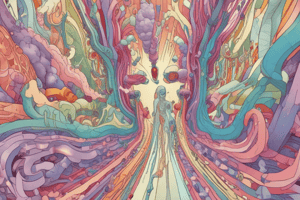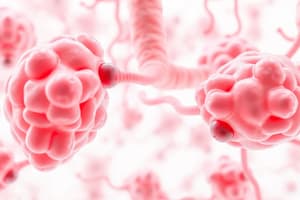Podcast
Questions and Answers
What is the primary function of the adrenal medulla in relation to the nervous system?
What is the primary function of the adrenal medulla in relation to the nervous system?
- It is functionally related to the sympathetic nervous system (correct)
- It is functionally related to the central nervous system
- It is functionally related to the peripheral nervous system
- It is functionally related to the parasympathetic nervous system
What percentage of the adrenal gland is comprised of the adrenal medulla?
What percentage of the adrenal gland is comprised of the adrenal medulla?
- 10% of the tissue
- 20% of the tissue (correct)
- 40% of the tissue
- 30% of the tissue
What is the primary enzyme responsible for the conversion of norepinephrine to epinephrine?
What is the primary enzyme responsible for the conversion of norepinephrine to epinephrine?
- Norepinephrine N-methyltransferase
- Dopamine beta-hydroxylase
- Phenylethanolamine-N-methyltransferase (correct)
- Tyrosine hydroxylase
What is the approximate percentage of epinephrine secreted by the adrenal medulla?
What is the approximate percentage of epinephrine secreted by the adrenal medulla?
What is the origin of the adrenal medulla?
What is the origin of the adrenal medulla?
What are the two main catecholamines secreted by the adrenal medulla?
What are the two main catecholamines secreted by the adrenal medulla?
What is the primary function of the catecholamines produced by the adrenal medulla?
What is the primary function of the catecholamines produced by the adrenal medulla?
What is the primary function of the zona glomerulosa in the adrenal cortex?
What is the primary function of the zona glomerulosa in the adrenal cortex?
What is the role of dopamine in the adrenal medulla?
What is the role of dopamine in the adrenal medulla?
What is the collective term for the >24 steroid hormones produced by the adrenal cortex?
What is the collective term for the >24 steroid hormones produced by the adrenal cortex?
Which hormone is responsible for regulating blood pressure through its effect on renal function?
Which hormone is responsible for regulating blood pressure through its effect on renal function?
What is the primary function of the zona reticularis in the adrenal cortex?
What is the primary function of the zona reticularis in the adrenal cortex?
What is the rate-limiting step in the synthesis of adrenocortical hormones?
What is the rate-limiting step in the synthesis of adrenocortical hormones?
What is the primary function of mineralocorticoids?
What is the primary function of mineralocorticoids?
Which of the following steroids is not primarily synthesized by the adrenal cortex?
Which of the following steroids is not primarily synthesized by the adrenal cortex?
What is the immediate precursor to all adrenocortical hormones?
What is the immediate precursor to all adrenocortical hormones?
What is the main site of adrenocortical hormone synthesis?
What is the main site of adrenocortical hormone synthesis?
Which of the following is NOT essential for life?
Which of the following is NOT essential for life?
What is the primary cause of decreased cortisol levels in Addison's disease?
What is the primary cause of decreased cortisol levels in Addison's disease?
Which of the following is NOT a symptom of Addison's disease?
Which of the following is NOT a symptom of Addison's disease?
What is the purpose of the 'feed forward' mechanism in Addison's disease?
What is the purpose of the 'feed forward' mechanism in Addison's disease?
What is the primary difference between Addison's disease and secondary adrenal insufficiency?
What is the primary difference between Addison's disease and secondary adrenal insufficiency?
Which of the following is a symptom of the loss of adrenal androgens in women with Addison's disease?
Which of the following is a symptom of the loss of adrenal androgens in women with Addison's disease?
What is the primary treatment for Addison's disease?
What is the primary treatment for Addison's disease?
What is the primary function of ACTH in regulating cortisol secretion?
What is the primary function of ACTH in regulating cortisol secretion?
What is the diurnal pattern of cortisol secretion driven by?
What is the diurnal pattern of cortisol secretion driven by?
What is the effect of sleep loss on the hypothalamic-pituitary-adrenal (H-P-A) axis?
What is the effect of sleep loss on the hypothalamic-pituitary-adrenal (H-P-A) axis?
What is the characteristic of cortisol secretion?
What is the characteristic of cortisol secretion?
What is the effect of coma, blindness, or constant exposure to either light or dark on the diurnal pattern of cortisol secretion?
What is the effect of coma, blindness, or constant exposure to either light or dark on the diurnal pattern of cortisol secretion?
What is the nocturnal peak of ACTH driven by?
What is the nocturnal peak of ACTH driven by?
The adrenal medulla produces more than 24 steroid hormones collectively known as corticosteroids.
The adrenal medulla produces more than 24 steroid hormones collectively known as corticosteroids.
Aldosterone is a glucocorticoid produced by the zona fasciculata of the adrenal cortex.
Aldosterone is a glucocorticoid produced by the zona fasciculata of the adrenal cortex.
Dopamine increases heart rate and blood pressure by stimulating the adrenal medulla.
Dopamine increases heart rate and blood pressure by stimulating the adrenal medulla.
The zona reticularis of the adrenal cortex produces aldosterone.
The zona reticularis of the adrenal cortex produces aldosterone.
CRH stimulates the adrenal medulla to release catecholamines.
CRH stimulates the adrenal medulla to release catecholamines.
The adrenal medulla is responsible for regulating blood pressure through the release of aldosterone.
The adrenal medulla is responsible for regulating blood pressure through the release of aldosterone.
Aldosterone increases sodium reabsorption from the tubular epithelial cells of kidney back into the blood while simultaneously moving potassium ions from the blood into the kidneys for eventual excretion in urine.
Aldosterone increases sodium reabsorption from the tubular epithelial cells of kidney back into the blood while simultaneously moving potassium ions from the blood into the kidneys for eventual excretion in urine.
Elevated [K+] levels in blood decrease aldosterone secretion.
Elevated [K+] levels in blood decrease aldosterone secretion.
Mineralocorticoids increase K+ reabsorption in the kidneys.
Mineralocorticoids increase K+ reabsorption in the kidneys.
Corticosterone is the primary glucocorticoid hormone in humans.
Corticosterone is the primary glucocorticoid hormone in humans.
The rate-limiting step in the synthesis of adrenocortical hormones is catalyzed by cholesterol desmolase.
The rate-limiting step in the synthesis of adrenocortical hormones is catalyzed by cholesterol desmolase.
Corticosterone circulates in blood at 10-20-fold higher levels than cortisol.
Corticosterone circulates in blood at 10-20-fold higher levels than cortisol.
The secretion of glucocorticoids by the zona fasciculata/reticularis is regulated exclusively by the hypothalamic-pituitary axis and the kidney.
NOT KIDNEY
The secretion of glucocorticoids by the zona fasciculata/reticularis is regulated exclusively by the hypothalamic-pituitary axis and the kidney. NOT KIDNEY
ACTH stimulates the transfer of stored cholesterol to the mitochondria and inhibits cholesterol desmolase.
ACTH stimulates the transfer of stored cholesterol to the mitochondria and inhibits cholesterol desmolase.
The diurnal pattern of cortisol secretion is driven by the hypothalamus and the pituitary gland.
The diurnal pattern of cortisol secretion is driven by the hypothalamus and the pituitary gland.
The highest secretory rates of cortisol occur just after falling asleep.
The highest secretory rates of cortisol occur just after falling asleep.
Partial acute sleep loss accelerates the recovery of the H-P-A axis.
Partial acute sleep loss accelerates the recovery of the H-P-A axis.
The diurnal pattern of cortisol secretion is not altered or abolished by coma, blindness, or constant exposure to either light or dark.
The diurnal pattern of cortisol secretion is not altered or abolished by coma, blindness, or constant exposure to either light or dark.
In Hypocortisolism, such as Addison disease, Hyperglycemia is typically observed.
In Hypocortisolism, such as Addison disease, Hyperglycemia is typically observed.
Cortisol induces the synthesis of lipocortin, which stimulates the enzyme phospholipase A2.
Cortisol induces the synthesis of lipocortin, which stimulates the enzyme phospholipase A2.
Cortisol up-regulates β2-adrenergic receptors on arterioles, leading to vasodilation.
Cortisol up-regulates β2-adrenergic receptors on arterioles, leading to vasodilation.
In Hypercortisolism, blood pressure is typically decreased.
In Hypercortisolism, blood pressure is typically decreased.
Cortisol increases REM sleep and decreases slow-wave sleep.
Cortisol increases REM sleep and decreases slow-wave sleep.
Glucocorticoid receptors are not found in the brain.
Glucocorticoid receptors are not found in the brain.
Failing to comply with a medically prescribed steroid taper can lead to Addisonian Crisis, a medical emergency with a high mortality rate.
Failing to comply with a medically prescribed steroid taper can lead to Addisonian Crisis, a medical emergency with a high mortality rate.
Cushing's Disease is caused by an adrenal gland tumor.
Cushing's Disease is caused by an adrenal gland tumor.
Both Cushing's Disease and Cushing's Syndrome result from a deficiency of cortisol.
Both Cushing's Disease and Cushing's Syndrome result from a deficiency of cortisol.
Dehydration is a symptom of Addisonian Crisis.
Dehydration is a symptom of Addisonian Crisis.
Cushing's Syndrome is always caused by a pituitary tumor.
Cushing's Syndrome is always caused by a pituitary tumor.
Flashcards are hidden until you start studying
Study Notes
Adrenal Gland Structure and Function
- Adrenal gland consists of two parts: adrenal medulla (inner zone) and adrenal cortex (outer zone)
- Adrenal medulla produces catecholamines (epinephrine and norepinephrine) and is functionally related to the sympathetic nervous system
- Adrenal cortex produces mineralocorticoids, glucocorticoids, and androgens
Adrenal Cortex Zones
- Zona glomerulosa (outer zone): produces mineralocorticoids (aldosterone)
- Aldosterone regulates sodium and potassium balance
- Enzyme aldosterone synthase is involved in its synthesis
- Zona fasciculata (middle zone): produces glucocorticoids (cortisol)
- Cortisol influences carbohydrate, fat, and protein metabolism
- Zona reticularis (inner zone): produces weak androgens (dehydroepiandrosterone and androstenedione) and some glucocorticoids
Regulation of Glucocorticoid Secretion
- Regulated exclusively by the hypothalamic-pituitary axis
- ACTH (adrenocorticotropic hormone) stimulates the transfer of stored cholesterol to the mitochondria and activates cholesterol desmolase
- ACTH has a pulsatile and diurnal secretory pattern, driving a parallel pattern of cortisol secretion
- Nocturnal peak of ACTH is driven by a burst of CRH (corticotropin-releasing hormone) secretion
Diurnal Pattern of Cortisol Secretion
- Average of 10 secretory bursts over 24 hours
- Lowest secretory rates occur during evening hours and just after falling asleep
- Highest secretory rates occur just before awakening in the morning
- Hypothalamus acts as an "internal clock" to drive the diurnal pattern
- Diurnal pattern can be shifted by altering sleep-wake cycles or abolished by coma, blindness, or constant exposure to light or dark
Effects of ACTH and Cortisol
- ACTH stimulates the synthesis of cortisol
- Cortisol has anti-inflammatory effects, induces the synthesis of lipocortin, and inhibits the production of interleukin-2 and the proliferation of T lymphocytes
- Cortisol maintains vascular responsiveness to catecholamines and up-regulates α1-adrenergic receptors on arterioles
- Cortisol also affects the central nervous system, decreasing REM sleep, increasing slow-wave sleep, and increasing awake time
Disorders Related to Adrenal Gland
- Addison's disease: a disorder characterized by the loss of glucocorticoids and mineralocorticoids, resulting in hypoglycemia, anorexia, weight loss, and weakness
- Cushing's disease: a disorder characterized by hypersecretion of ACTH from a pituitary adenoma, resulting in excess secretion of cortisol
- Cushing's syndrome: a disorder characterized by excess secretion of cortisol from an adrenal gland tumor, resulting in signs and symptoms similar to Cushing's disease
Studying That Suits You
Use AI to generate personalized quizzes and flashcards to suit your learning preferences.




